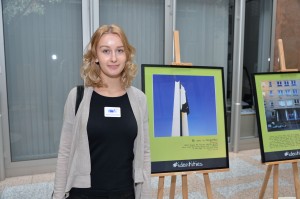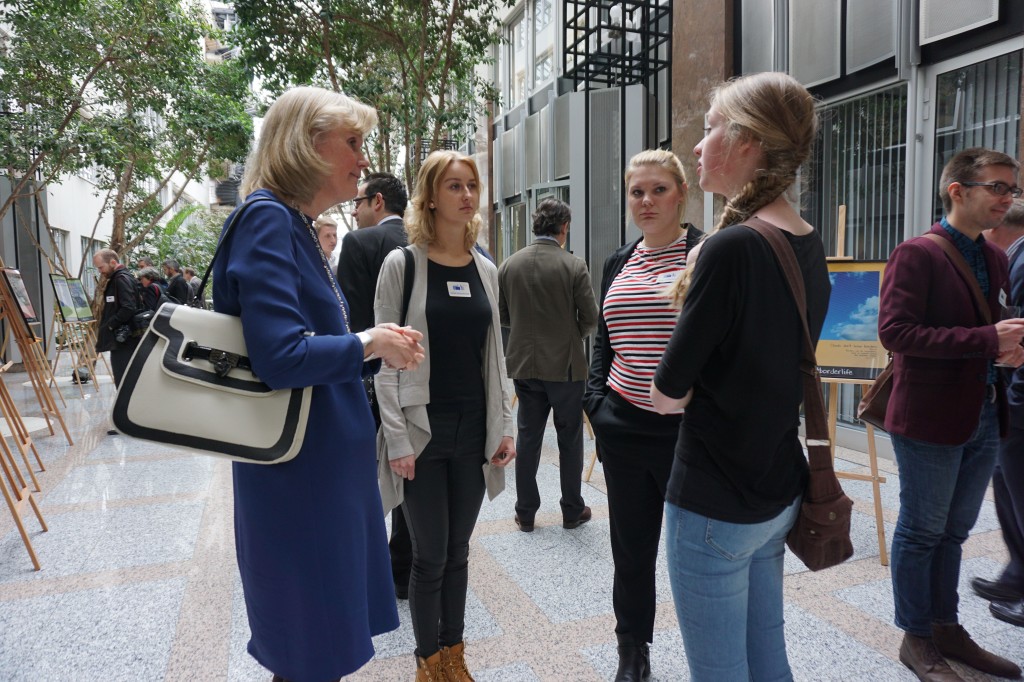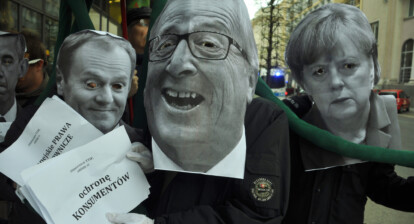Approximately seventy guests attended the opening of the #balticeye exhibition on 29 January, 2015 on the premises of the European Commission / Directorate-General for Regional Policy. #balticeye displays visual impressions by young Europeans on history and European and national identity. Maria Zatoplyaeva (18) from Kaliningrad/Russian Federation contributed several exhibits to it. For History Campus she explains why in her eyes identity is nothing you could explain in one sentence.
-

Maria in front of her own picture (photo: EU Commission/DG REGIO)
Well, I don’t think that I have completely understood neither the concept of identity nor my personal identity in particular. But after the one week History Camp in Estonia and Russia as part of the First Baltic Sea Youth Dialogue, I definitely came closer to understanding what it might be. Personally, I am sure that there always are multiple identities, layers of them. For example, I am a student, a young woman, a friend, a daughter, a girlfriend, a Baltic Sea lover, a traveller and an art admirer (and many more). All of those shape who I am now in equal proportion: single out just one layer and I won’t feel complete. You cannot change what has made you who you are, but you can develop further, go forth and multiply the layers. This is what makes up the beauty of living to me.
Cross-border Dialogue, but not one Common Identity

Participants of the 1st Baltic Sea Youth Dialogue in Narva (photo: Tina Gotthardt)
When I think about identity now I feel more comfortable with it. Honestly, the whole project of the First Baltic Sea Youth Dialogue rather gave me an understanding that we, the Youth of the Baltic Sea Region, are still drawn together. Maybe on the basis of our common age or laughter rather than sharing a common identity. In the end of our one week lasting seminar we came to a conclusion. Namely that we do not share one and the same thing.
Neither do we share one common European identity. I remember one particular task we were given during our week at the Estonian-Russian border: picture our common identity as a poster, filling it with drawings and pictures. We were going through tens of suggestions, but every time one of the 22 members denied it could be related to him/her. We ended up having a blank list in front of us. It was embarrassing but drew a clear realisation there was not much common between us. We all share different things but that can still work – laughing together and understand each other perfectly well was something that we often got to witness during our seminar in Estonia and Russia.
Sharing a European and a National Identity
I currently live in Newcastle, UK. I definitely feel a European identity. But the feeling does not stem from living in the UK (given that I’ve spent just slightly over half a year here). It is rather because I come from Kaliningrad. A city that is torn away from the big Russia and situated in Europe, and I’d say this rather shaped my perception of being European (on an honest note I’ve been to Berlin fourfold more than to Moscow). However, I can’t deny I feel my national identity, either, especially during the times of major sport events like the Olympic Games or World Finals. My national identity is rather linked to some kind of patriotism and love to the Russian culture than supporting the direction my home country has taken on the political arena today.
The Opening of the #balticeye Exhibition in Brussels

Having the chance to participate at the opening of the #balticeye exhibition in Brussels, I really enjoyed it greatly for a number of reasons. When I took pictures in Estonia and Russia in September 2014, I would have never guessed that they would be such a success when being exhibited in Brussels a couple of months later. The whole Brussels trip was like a reward for all the effort we put in back in September during the First Baltic Sea Youth Dialogue. I really liked the opening of the exhibition festivities in Brussels. It was really interesting, involved meeting people from the international community and old friends who I was more than happy to see.
A Journey from Seminars to Brussels
During the seminar in September 2014, we created friendship groups and tried to keep in touch with each other but unfortunately, I could not see all of them in Brussels. For me, it was also intriguing to see how people changed over the spin of 5 months even if we didn’t talk much. It was nice meeting them again. I had three of my own pictures exhibited in Brussels: The monument against the sky, all our legs (shoes) in a circle shot from above and the photo named #wherewecomefrom My sister against the Eye of Gdansk.

Maria Zatoplyaeva born 1996 in Kaliningrad/Russia (photo: EU Commission/DG REGIO)
None of these were one of my most favorite pictures: The one I loved the most was the one we took on the bank of Narva River. We used both drawing material to copy the castles situated on the banks of both rivers and took a picture of the drawing against an actual natural boarder. This was something we had to put imagination into. Finally turn on creativity we needed so much – that is probably the reason I fancy it most.”
Further Information
In September 2014, the Council of the Baltic Sea States in cooperation with Körber-Stiftung organised the first Baltic Sea Youth Dialogue. From their respective networks, they invited 25 young Europeans, aged 16-19, from 12 different countries to a weeklong program of workshops, lectures, debates and practical experiences in Tallinn and Narva (Estonia), as well as Ivangorod (Russian Federation). Coming from a generation that grew up in a Europe of free movement, the participants here developed their own perspective of history and different dimensions of their personal, cultural and regional identity. More information here.
In total, thirty photographs are printed, framed and exhibited in Brussels. They illustrate the topics #wherewecomefrom, #sharedpast, #borderlife, #identities and #ourgeneration. It can be admired till the end of February in Brussels on the premises of the European Commission / Directorate-General for Regional Policy, Beaulieu 1.
More about the exhibition in Brussels here.
More about the project #balticeye here
More about Maria’s group theme: #identities here
More about the participants of the First Baltic Sea Youth Dialogue here





